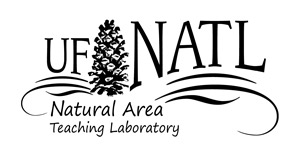| UF Academic Use | Public Use | Family Fun and K-12 Education |

Management Plans
This section summarizes the Natural Area Advisory Committee's plans for NATL. These plans include new projects and the continuance and completion of old ones. At the end of this section is a schedule of planned actions. As these are accomplished they are logged in Actions Taken.
Land-use plan
NAAC maintains a land-use plan that may be updated by procedures described in it Operating Policies. The last update, in 2008, increased the area of the upland pine to be restored in the restricted area of NATL-west. This map includes that change.
Infrastructure for NATL-east
The following should be done to increase the usefulness of NATL-east: make a grid-based soil survey (done in NATL-west in 2000) and populate the kiosk that has been ereceted near is north entrance.
Trash--old and new
Legacy trash should be removed as it is discovered or uncovered during tilling. Users of NATL should be encouraged to avoid littering and to pick up and properly dispose of litter deposited by others.
Publicity
The NATL web site (http://natl.ifas.ufl.edu) should be used to publicize all aspects of NATL.
Pamphlets summarizing the most important aspects of NATL should be available at the kiosks near the NATL pavilion and in Natural Area Park.
Access issues
The northern portion of NATL-west, including Natural Area Park, the five successional plots, the SEEP retention basin, and the northern portions of the upland pine and hammock ecosystems, is designated a public area (see map) with all interested persons being encouraged to use the area in any appropriate way and especially to learn from the nature trails in that area.
NATL-west south of Division Trail and all of NATL-east are designated "restricted areas" (for academic use only) (see map). This protects these portions of NATL from harm by too much foot traffic and facilitates their use by classes and for special projects. Signs at the entrances to these areas should indicate that they are to be entered only for academic purposes and should give a URL for learning the details of the usage policies.
Grid-based photographic record
The grid-based photographic record of NATL started in 1997 should be updated at intervals no greater than 10 years.
Hardwood Forest
Invasive exotic plants, including mimosa, Ardisia, climbing tree fern, and air potato should be controlled or extirpated.
Upland Pine
Most of the upland pine area of NATL (see map) will be restored to as near its original state as practicable. One to two acres in both the public and restricted areas will be left unburned to demonstrate the effects of eliminating fire from upland pine. During the course of restoration, methods of restoration and areas treated will be scheduled to maximize values for teaching and for demonstrating methods of restoration to those using the nature trails.
Once restored, the upland pine will be maintained by burning approximately one fourth of its area each year. Burning at 3- to 6-year intervals should maintain the upland pine species, and doing some burning every year will allow students each year to see immediate and longer-term effects of burning.
Old-field Plots
The succession area will be maintain as three management units (see map) that will be cleared and cultivated at 1-year, 5-year, and 10-year intervals and after 10 years all of the plots will be cleared and rotated. For example, after 10 years the 1-year plot will become the new 10-year plot, the 5-year plot will become the new 1-year plot, and the 10-year plot will become the new 1-year plot. The goal is to exhibit three plots that represent NATL's current seed bank and prevent these plots from transitioning into closed forests. The dense stands of cogongrass and other invasive plantss will be eliminated by applying herbicides. Mature longleaf pines in the successional plots will not be cut when the plots are otherwise cleared and tilled.
Retention Pond
NATL-west's retention pond has been ecologically engineered by the Wetlands Club in its Stormwater Ecological Enhancement Project (SEEP). The many species of native wetland plants established in SEEP by the Wetlands Club will be allowed to compete as they respond to the varied hydrological cycles produced by recontouring the retention basis. The resulting biotic communities will change as the trees planted by the Wetlands Club mature and the vegetational structure of SEEP becomes more complex and suited to a greater variety of wildlife.
Temporary Pools
Shallow depressions that periodically fill with rain water are essential to the breeding of some amphibians. An excavation in the southwest corner of successional plot D is intended to provide an ephemeral pond for amphibian breeding.
Sinkhole Pond
The sinkhole and adjacent pond will be cleared of debris and not altered otherwise. If debris is washing into the pond from storm drainage from Archer Road, DOT should be notified of the problem and asked if it can be remedied.
Schedule of planned actions
A schedule of planned actions, updated annually by the Natural Area Advisory Committee, is posted on the north side of the academic kiosk (near the pavilion).


